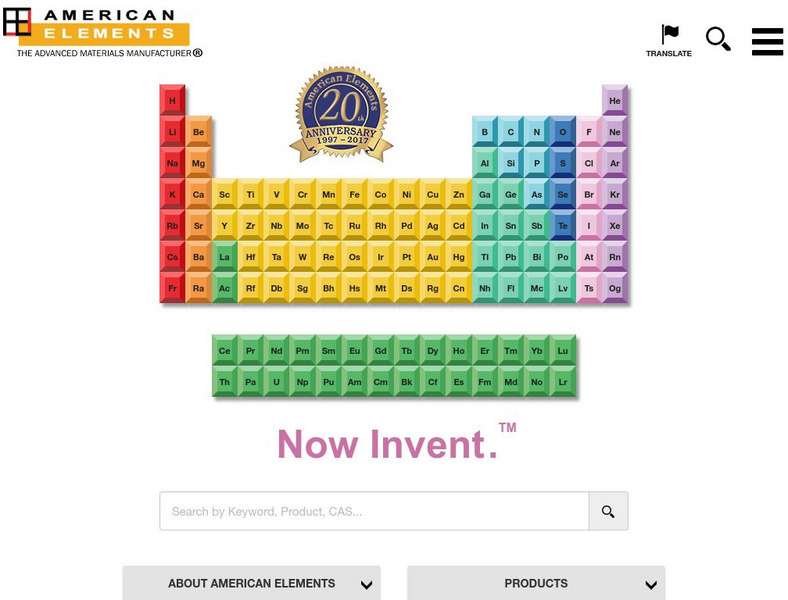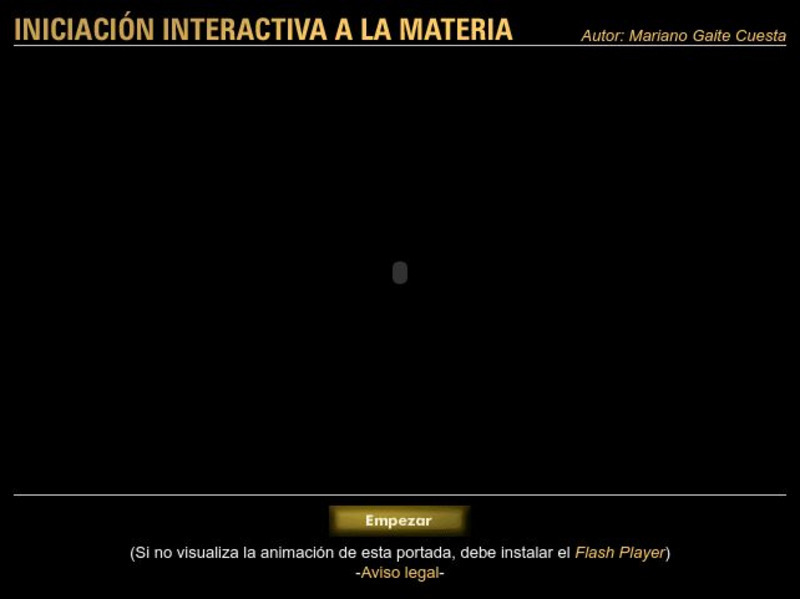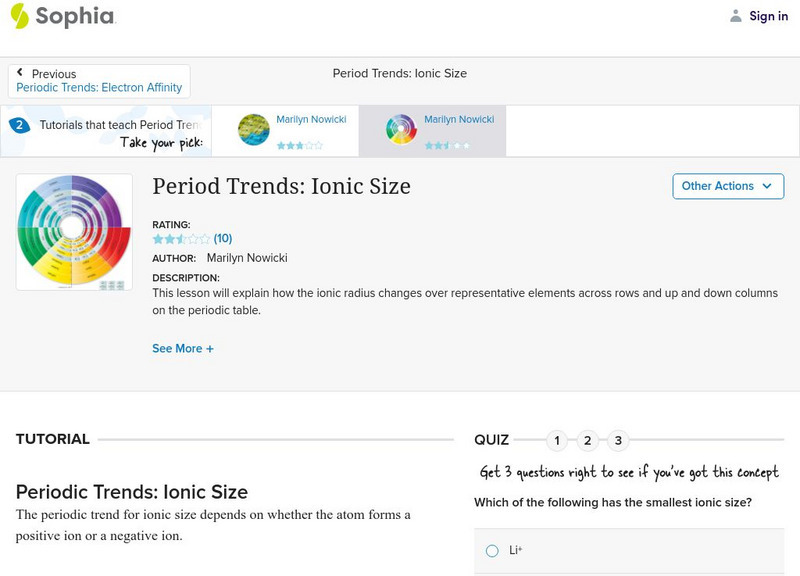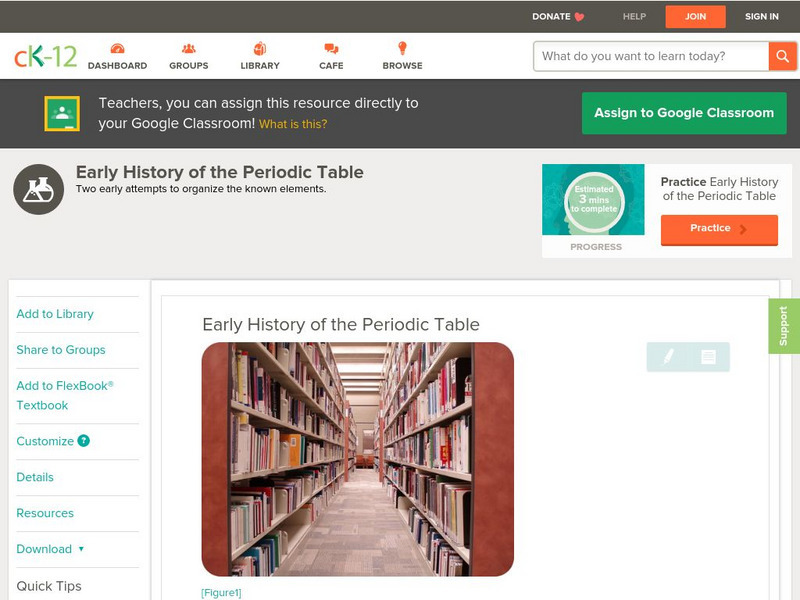Other
Chemical Elements: Potassium
A nice, clear site, containing a good deal of elemental information, including atomic weight, density, boiling point, isotopes and more. An image shows the electron energy levels for the element.
Other
Chemical Elements: Plutonium
A nice, clear site, containing a good deal of elemental information, including; atomic weight, density, boiling point, isotopes and more. An image shows the electron energy levels for the element.
University of Victoria (Canada)
A Brief History of the Development of Periodic Table
Provides information on the development of the periodic table under the following sections: In the Beginning, Law of Triads, First Attempts At Designing a Periodic Table, Law of Octaves, Who Is the Father of the Periodic Table?,...
Other
Moscow University: Dmitriy Mendeleev Online
This site from Moscow University contains links to other Mendeleev sites. Links are categorized by the following topic areas: Overviews, Writings, Pictures, Periodic Laws, Periodic Tables, and Russian resources.
Other
Moscow State University: Dmitri Mendeleev Online
Moscow State University offers resource links about Dmitri Mendeleev, a Russian chemist. Includes biographies, writings, pictures, periodic laws, and more.
Other
American Elements: Periodic Table of Elements
An interactive periodic table of elements allows users to click on elements and discover the details of each one.
Scholastic
Scholastic: Study Jams! Science: Matter: Periodic Table
A video and a short quiz on the periodic table of elements and how it is organized.
Scholastic
Scholastic: Study Jams! Science: Matter: Elements & Compounds
A video and a short quiz on elements, how they combine through chemical reactions to make compounds, and how to write the chemical formulas for water and salt.
Scholastic
Scholastic: Study Jams! Science: Matter: Atoms: Protons, Neutrons, Electrons
A video and a short quiz on the parts of an atom, the periodic table, and molecules.
Other
Chemistry Resources: The Elements: Alkali Metals
This subtable lists and describes the six alkali metals of the periodic table of Elements. Related links are provided.
Ministerio de Educacion, Cultura y Deporte (Spain)
Cnice: Iniciacion Interactiva a La Materia
Matter is anything that has mass and occupies a space. In this site you will find a lot of illustrations and interactive activities dealing with matter.
Sophia Learning
Sophia: Metallic Character: Lesson 3
This lesson will describe metallic character and describe how it changes throughout the periodic table. It is 3 of 3 in the series titled "Metallic Character."
Chem4kids
Chem4 Kids: Families Stick Together
Beyond columns and rows, the periodic table groups elements according to families. Identify the families present on the table with this overview.
Chem4kids
Chem4 Kids: The Noble Gases
Get the skinny on the noble gases on the periodic table. Find out why this family is happy, how well they bond, and exactly who is a part of this happy family.
Chem4kids
Chem4 Kids: Alkali Metals to the Left
To the left. To the left. The elements in the left column of the period table are alkali metals with the exception of hydrogen. This is a brief overview of the alkali metals, what their family is all about and how well they bond or do...
Chem4kids
Chem4 Kids: Heading to Group Two
The second family in the periodic table is the alkaline earth metals found in the second column from the left. Meet the family and get to familiar with why this is the second most reactive group of elements.
Sophia Learning
Sophia: Chemical Reactions: Lesson 4
This lesson will present a basic understanding of the periodic chart of elements and how to predict chemical reactions based on given information. It is 4 of 9 in the series titled "Chemical Reactions."
Sophia Learning
Sophia: Periodic Table: Lesson 4
Explain how elements on the periodic table are arranged, and explain the relationships within each row and column. This lesson is 4 of 4 in the series titled "Periodic Table."
Sophia Learning
Sophia: Period Trends: Ionic Size: Lesson 3
This lesson will explain how the ionic radius changes over representative elements across rows and up and down columns on the periodic table. It is 3 of 3 in the series titled "Period Trends: Ionic Size."
Museum of Science
Museum of Science and Industry Chicago: Elements: Reactions
An interactive periodic table of elements where learners can experiment with combining many elements to see what they can create.
TeachEngineering
Teach Engineering: Understanding Elements
This lesson plan examines the properties of elements and the periodic table. Students learn the basic definition of an element and the 18 elements that build most of the matter in the universe. The periodic table is described as one...
CK-12 Foundation
Ck 12: Chemistry: Alkaline Earth Metals
[Free Registration/Login may be required to access all resource tools.] Covers alkaline earth elements, electron configuration and reactions.
CK-12 Foundation
Ck 12: Chemistry: Atomic Number
[Free Registration/Login may be required to access all resource tools.] Explains the arrangement of the periodic table.
CK-12 Foundation
Ck 12: Chemistry: Early History of the Periodic Table
[Free Registration/Login may be required to access all resource tools.] Describes the history of the periodic table, the Dobereiner triads, and the Newland octaves.

























